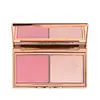What's inside
What's inside
 Key Ingredients
Key Ingredients

 Benefits
Benefits

 Concerns
Concerns

 Ingredients Side-by-side
Ingredients Side-by-side

Octyldodecanol
EmollientIsocetyl Stearoyl Stearate
EmollientIsodecyl Neopentanoate
EmollientBis-Diglyceryl Polyacyladipate-2
EmollientCandelilla Cera
EmollientDiisostearyl Malate
EmollientNeopentyl Glycol Diheptanoate
EmollientOryza Sativa Bran Wax
Skin ConditioningTriethylhexanoin
MaskingPolymethylsilsesquioxane
Silica
AbrasiveCopernicia Cerifera Cera
EmollientHydrogenated Polyisobutene
EmollientEthylhexyl Palmitate
EmollientAluminum Hydroxide
EmollientTetrahexyldecyl Ascorbate
AntioxidantTribehenin
EmollientTocopheryl Acetate
AntioxidantSorbitan Isostearate
EmulsifyingPalmitoyl Tripeptide-1
Skin ConditioningTrihydroxystearin
Skin ConditioningSodium Hyaluronate
HumectantCI 19140
Cosmetic ColorantCI 77891
Cosmetic ColorantCI 15850
Cosmetic ColorantIron Oxides
CI 42090
Cosmetic ColorantCI 45410
Cosmetic ColorantOctyldodecanol, Isocetyl Stearoyl Stearate, Isodecyl Neopentanoate, Bis-Diglyceryl Polyacyladipate-2, Candelilla Cera, Diisostearyl Malate, Neopentyl Glycol Diheptanoate, Oryza Sativa Bran Wax, Triethylhexanoin, Polymethylsilsesquioxane, Silica, Copernicia Cerifera Cera, Hydrogenated Polyisobutene, Ethylhexyl Palmitate, Aluminum Hydroxide, Tetrahexyldecyl Ascorbate, Tribehenin, Tocopheryl Acetate, Sorbitan Isostearate, Palmitoyl Tripeptide-1, Trihydroxystearin, Sodium Hyaluronate, CI 19140, CI 77891, CI 15850, Iron Oxides, CI 42090, CI 45410
Talc
AbrasiveOryza Sativa Starch
AbsorbentMica
Cosmetic ColorantDimethicone
EmollientOctyldodecyl Stearoyl Stearate
EmollientAluminum Hydroxide
EmollientZinc Stearate
Cosmetic ColorantCaprylyl Glycol
EmollientPhenoxyethanol
PreservativeDimethiconol
EmollientHexylene Glycol
EmulsifyingIsononyl Isononanoate
EmollientDimethicone/Vinyl Dimethicone Crosspolymer
Skin ConditioningPolymethylsilsesquioxane
Silica
AbrasiveTrimethylsiloxysilicate
EmollientCI 77891
Cosmetic ColorantIron Oxides
CI 19140
Cosmetic ColorantCI 15985
Cosmetic ColorantCI 15850
Cosmetic ColorantCI 73360
Cosmetic ColorantSqualane
EmollientDiisostearyl Malate
EmollientBoron Nitride
AbsorbentHdi/Trimethylol Hexyllactone Crosspolymer
Zea Mays Starch
AbsorbentEthylhexylglycerin
Skin ConditioningMaltodextrin
AbsorbentTin Oxide
AbrasiveCI 75470
Cosmetic ColorantTalc, Oryza Sativa Starch, Mica, Dimethicone, Octyldodecyl Stearoyl Stearate, Aluminum Hydroxide, Zinc Stearate, Caprylyl Glycol, Phenoxyethanol, Dimethiconol, Hexylene Glycol, Isononyl Isononanoate, Dimethicone/Vinyl Dimethicone Crosspolymer, Polymethylsilsesquioxane, Silica, Trimethylsiloxysilicate, CI 77891, Iron Oxides, CI 19140, CI 15985, CI 15850, CI 73360, Squalane, Diisostearyl Malate, Boron Nitride, Hdi/Trimethylol Hexyllactone Crosspolymer, Zea Mays Starch, Ethylhexylglycerin, Maltodextrin, Tin Oxide, CI 75470
Ingredients Explained
These ingredients are found in both products.
Ingredients higher up in an ingredient list are typically present in a larger amount.
Aluminum Hydroxide is a form of aluminum. It can be naturally found in nature as the mineral gibbsite. In cosmetics, Aluminum Hydroxide is used as a colorant, pH adjuster, and absorbent.
As a colorant, Aluminum Hydroxide may add opacity, or reduce the transparency. Aluminum hydroxide is contains both basic and acidic properties.
According to manufacturers, this ingredient is an emollient and humectant. This means it helps hydrate the skin.
In medicine, this ingredient is used to help relieve heartburn and help heal ulcers.
There is currently no credible scientific evidence linking aluminum hydroxide in cosmetics to increased cancer risk.
Major health organizations allow the use of aluminum hydroxide in personal care products and have not flagged it as a carcinogenic risk at typical usage levels.
Learn more about Aluminum HydroxideCi 15850 is the pigment color red. It is an azo dye and created synthetically.
Azo dyes need to be thoroughly purified before use. This allows them to be more stable and longer-lasting.
This ingredient is common in foundations, lipsticks, and blushes. This color is described as brown/orangey red.
It has many secondary names such as Red 6 and Red 7. According to a manufacturer, Red 6 usually contains aluminum.
Learn more about CI 15850CI 19140 is also known as Tartrazine. Tartrazine is a synthetic dye used in cosmetics, foods, and medicine to add a yellow color.
Tartrazine is created from petroleum and is water-soluble.
Some people may experience allergies from this dye, especially asthmatics and those with an aspirin intolerance.
Learn more about CI 19140Ci 77891 is a white pigment from Titanium dioxide. It is naturally found in minerals such as rutile and ilmenite.
It's main function is to add a white color to cosmetics. It can also be mixed with other colors to create different shades.
Ci 77891 is commonly found in sunscreens due to its ability to block UV rays.
Learn more about CI 77891Diisostearyl Malate is an emollient and most often used in lip products. It comes from isostearyl alcohol, a fatty acid, and malic acid, an AHA.
As an emollient, Diisostearyl Malate helps create a thin film on your skin to trap moisture in. This helps keep your skin soft and smooth.
Polymethylsilsesquioxane is a silicone used as a film forming agent.
When applied to the skin, this ingredient creates an invisible film on the surface. This film still allows oxygen to pass through, but prevents moisture from escaping. This can help condition and hydrate the skin. It also leaves a silky feel when applied.
Polymethylsilsesquioxane has not been shown to clog pores. It has been deemed safe to use up to 55%, but most cosmetics use much less.
If you have concerns about using this ingredient, we recommend speaking with a professional.
Learn more about PolymethylsilsesquioxaneSilica, also known as silicon dioxide, is a naturally occurring mineral. It is used as a fine, spherical, and porous powder in cosmetics.
Though it has exfoliant properties, the function of silica varies depending on the product.
The unique structure of silica enhances the spreadability and adds smoothness, making it a great texture enhancer.
It is also used as an active carrier, emulsifier, and mattifier due to its ability to absorb excess oil.
In some products, tiny microneedles called spicules are made from silica or hydrolyzed sponge. When you rub them in, they lightly polish away dead skin layers and enhance the penetration of active ingredients.
Learn more about SilicaThis ingredient is a combination of red, black, and yellow iron oxide pigments. This combination of colors is usually found in foundation, because it results in a "skin" color.